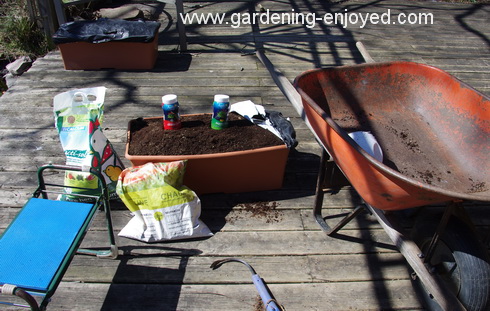
In the previous issue of “Dallying” I showed you the Earthbox warming in the solarium and a couple of weeks later I have finally begun to get them ready for planting. I am still a couple of weeks ahead of schedule and that is one of the few good things to come out of our enforced staying at home. Once I worked on the nice warm box from the solarium I found that the ones in the garden had cold soil to work with but they were not frozen and that allowed me to move ahead more quickly. It was wonderful to be able to do this by myself, as last year I was very restricted in similar activities by the shoulder surgery. In this picture you can see my process for preparing these containers for this year’s planting. I pull out all of the remains of last year’s plants, something I should have done last autumn, and then dump the soil into the
wheelbarrow. I loosen all of that soil and remove any large roots that I find and then return the soil to the washed container. As per Earthbox’s instructions, I add a cup or so of fine dolomitic limestone when the box is about 2/3 full and mix it in a bit. I have a significant quantity of a couple of new products from the Acti-sol fertilizer people. Their Shrimp meal, a transplant helper and their Kelp meal, a soil amendment are being added to the soil as I fill the box. These products were to be given out at our Garden Communicators meeting in March but, of course, it was cancelled leaving me with a more than adequate supply. Since I have them, why not try them. The preparation is finished by adding the 2+ cups of Acti-solfertilizer in a furrow near the top of the soil and then putting the plastic mulch cover on and waiting for planting time. Right now I have 8 boxes ready to go.
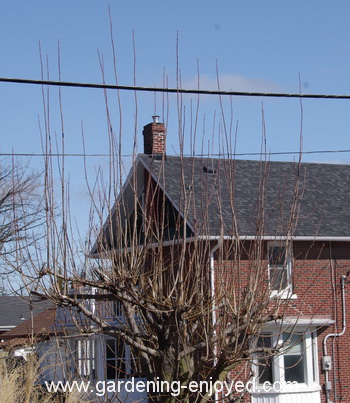 Here’s a regular late winter chore. The trick is to time it so that the results are ready to be picked up by the first municipal yard waste pickup. This is the Harlequin Maple tree that I planted in the front yard some twenty years ago when we first moved here. It was a great idea at the time but like many landscape designs, there was insufficient thought about the mature size of the plant. If I let it grow it would be shading too much of my front perennial beds and so a few years ago I started to prune it. It got bigger, I got older.
Here’s a regular late winter chore. The trick is to time it so that the results are ready to be picked up by the first municipal yard waste pickup. This is the Harlequin Maple tree that I planted in the front yard some twenty years ago when we first moved here. It was a great idea at the time but like many landscape designs, there was insufficient thought about the mature size of the plant. If I let it grow it would be shading too much of my front perennial beds and so a few years ago I started to prune it. It got bigger, I got older.
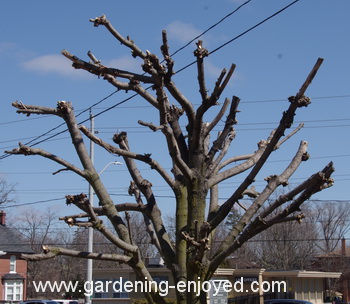 Now we pollard it. That’s a process of reducing it, each year, to a relatively small head of large branches that then produce an amazing amount of new growth each year. The longest of those new shoots are close to 3m long. The problem, of course, is that the variegated foliage that makes a Harlequin Maple attractive is mostly lost in this amazing growth. The real solution is to admit my mistake and dig it out and replace it with a smaller specimen; there’s a flowering Dogwood I have my eye on. That’s a big job and it has to be sort of sneaky as I planted this on the town’s property and that now makes it a town tree, it even has a little metal inventory tag on it. Maybe some long warm night????
Now we pollard it. That’s a process of reducing it, each year, to a relatively small head of large branches that then produce an amazing amount of new growth each year. The longest of those new shoots are close to 3m long. The problem, of course, is that the variegated foliage that makes a Harlequin Maple attractive is mostly lost in this amazing growth. The real solution is to admit my mistake and dig it out and replace it with a smaller specimen; there’s a flowering Dogwood I have my eye on. That’s a big job and it has to be sort of sneaky as I planted this on the town’s property and that now makes it a town tree, it even has a little metal inventory tag on it. Maybe some long warm night????
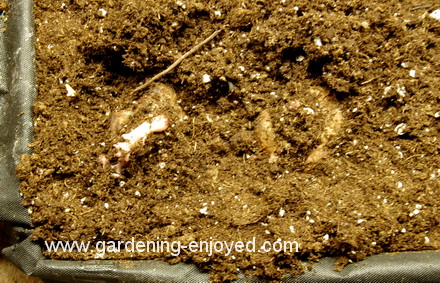
Tuberous Begonias stay out in the autumn until the first frost knocks the tops down. I have all new Begonias this year. The first frost last year wasn’t until 02 November and it hit - 7C which did more than knock the top growth off. The soil and tubers were frozen and thawed into mush a few days later. My local garden centre is closed except for curbside service. I called and asked them to put about 8 tubers, all different, into a bag and I would be down to collect them. They were a wonderful selection and I planted them this week. As you can see from the picture I planted all 8 in one flat to save space and I will separate them when the tops have grown enough to touch each other. It’s a technique that I have found to be quite successful in previous years. I do like my Tuberous Begonias, they have such lovely foliage and large colourful blooms and most of all they perform well in quite heavy shade.
Many thanks to folks at Vandermeers who picked out the tubers for me. I would probably have spent way too much time deciding which ones to buy.
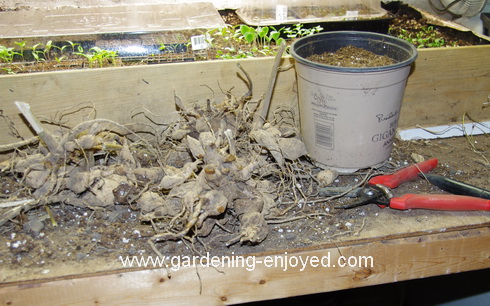
A couple of days later I tackled the tub of Dahlia tubers that I had dug up last fall. The hard frost didn’t get to them because they were growing in the garden rather than in pots. I put them in the basement in a big trug with every intention of cleaning them up and storing them properly as soon as the soil on them had dried. There they were, exactly where I had put them the day I dug them up. In that trug were six large clumps of dried soil around some large masses of tubers. Cleaning them and dividing them was a good reminder to do a better job of storing them this fall. If I can remember. Dahlia tubers have always fascinated me as they really are the deadest looking pieces of stuff and I can’t believe that they will wake up and grow but they always seem to. I have to break up the tubers into smaller clumps in order to get them into even the largest pots I have to start them in. It takes some will power to choose one good looking clump and throw away all the rest
of the material. Some of it is rotten or damaged but there are always two or three other good pieces and reminding myself that I just don’t have room is the difficult part. In these days of physical distancing, there are no meetings to go to where I could give them away.
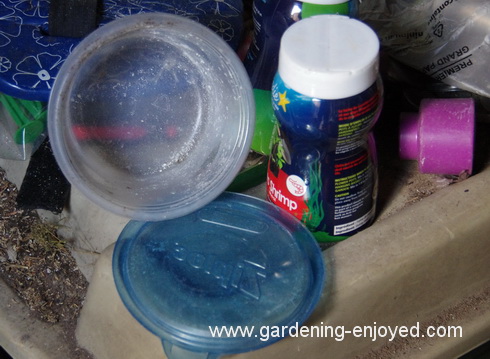
My garage is very old and full of holes so a variety of creatures can easily wander in and check it out. The contents of this now empty Tupperware container were enjoyed by something. Regular readers may remember that I use a tablespoon of powdered milk with each Tomato plant to prevent blossom end rot and this was the container that held that milk. I noticed the lid was off one day in the winter so I put it back on and made sure it was as secure as possible. Apparently one of my visiting creatures is quite capable of opening such a container. Now, of course, I’ll have to go and find a new package of powdered milk by the last week of May and remind myself to store it in the house this coming winter. It’s always a contest with Mother Nature and her helpers.
To ask a question just “reply” to this ezine. Don’t forget to check the front page of the Website for frequent short ideas for current
gardening activities.
Ann Asks?Every year, just as my crocus are beginning to bloom, something eats them, both leaves and flowers. I don't know if it's deer, rabbits, or a woodchuck, as I have never found any telltale droppings nearby. I thought I had found a solution by sprinkling moth balls around and among them. This seemed to work for a couple of years, but not this year. My crocus have been eaten once again. Sad smile Do you have any suggestions?
Ken Answers! Unintentionally feeding the creatures can be truly annoying. I do some strategic fencing but that doesn't work for something as small as Crocus. I use an animal repellent called Plantskyyd that should be available in your area, the problem here is that most Nurseries are closed although some are providing curbside service. This product is even safe to use on vegetables although I don't think I would want it on my lettuce leaves.
Ann Asks?I was
puttering around in my garden and discovered that one of my hostas appears to be rotting. It is an older variety that I got from my Mother many years ago with large plain green leaves and white flowers. Should I do anything- dig it out or ignore. I have many other types of hostas and don’t want it to spread if it is a pathogen
Ken Answers! Hard to tell what might be causing the rot but to be careful I might dig it out see if I could find a clean piece to replant but probably in a different location.
|

 Here’s a regular late winter chore. The trick is to time it so that the results are ready to be picked up by the first municipal yard waste pickup. This is the Harlequin Maple tree that I planted in the front yard some twenty years ago when we first moved here. It was a great idea at the time but like many landscape designs, there was insufficient thought about the mature size of the plant. If I let it grow it would be shading too much of my front perennial beds and so a few years ago I started to prune it. It got bigger, I got older.
Here’s a regular late winter chore. The trick is to time it so that the results are ready to be picked up by the first municipal yard waste pickup. This is the Harlequin Maple tree that I planted in the front yard some twenty years ago when we first moved here. It was a great idea at the time but like many landscape designs, there was insufficient thought about the mature size of the plant. If I let it grow it would be shading too much of my front perennial beds and so a few years ago I started to prune it. It got bigger, I got older. Now we pollard it. That’s a process of reducing it, each year, to a relatively small head of large branches that then produce an amazing amount of new growth each year. The longest of those new shoots are close to 3m long. The problem, of course, is that the variegated foliage that makes a Harlequin Maple attractive is mostly lost in this amazing growth. The real solution is to admit my mistake and dig it out and replace it with a smaller specimen; there’s a flowering Dogwood I have my eye on. That’s a big job and it has to be sort of sneaky as I planted this on the town’s property and that now makes it a town tree, it even has a little metal inventory tag on it. Maybe some long warm night????
Now we pollard it. That’s a process of reducing it, each year, to a relatively small head of large branches that then produce an amazing amount of new growth each year. The longest of those new shoots are close to 3m long. The problem, of course, is that the variegated foliage that makes a Harlequin Maple attractive is mostly lost in this amazing growth. The real solution is to admit my mistake and dig it out and replace it with a smaller specimen; there’s a flowering Dogwood I have my eye on. That’s a big job and it has to be sort of sneaky as I planted this on the town’s property and that now makes it a town tree, it even has a little metal inventory tag on it. Maybe some long warm night????


